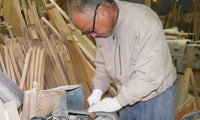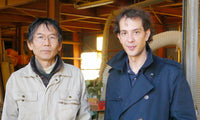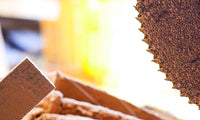Bokken, Bokuto, Daito, Tachi? Explanation!
The various terms used in Japan for swords and wooden swords
In the West, the word “Bokken” is widely used to refer to a wooden sword. However, in Japan, the proper word is “Bokuto”. Although less precise, the Japanese also use other terms like "Bokken" “Kidachi”, “Daito” and “Tachi” etc. Let’s see what the differences are and where those words come from.
Bokuto
木, ki/boku > wood
刀, katana/to > katana
The expression most commonly used in Japan is “bokuto”, 木刀, and it means, very simply, wooden katana. This is the most precise term to speak of a wooden sword that is made to imitate a katana.
Bokuto is the most widespread word in Japan, this is the one you will hear more or less everywhere when speaking about a wooden sword.
Bokken
木, ki/boku/moku > wood (read “bok” in bokken)
剣, ken > sword
The word “bokken” is less precise than “bokuto” as it means “wooden sword” in general. It can be a katana, but also any other type of sword.
The term bokken is also used in Japan, but mostly to refer to a bokuto / wooden katana. Although it is accepted that it has the same meaning as bokuto, you will very likely not hear this word often in Japan.

A classic Bokuto, Shinto Ryu Model
Kidachi / Tachi
木, ki/boku/moku > wood
太, futoi, ta > thick (read “da” in kidachi).
刀, katana, chi (read “chi” in kidachi)
“Tachi” refers to a long sword of at least 2 shaku (60.6 cm / 23.8 inches). It can be considered as a subcategory of the katana, but the tachi actually precedes the katana. It usually was longer, Lighter, with a stronger curvature, and carried mainly by the cavalry with the edge facing downwards.
That being said, the word tachi is used today in conversational Japanese to refer to a katana, no matter its precise shape.
Kidachi means, naturally, a wooden tachi. Although this word is not common in Japan, you might hear it in some Koryu.

A long and heavily curved ancient Tachi
Daito
大, dai. Tai > long/big
刀, katana/to > katana
The word daito is a more generic term for “long sword”. It is mainly used to refer to the long sword, as counterpart of the short sword called wakizashi or Shoto (小刀 > Small/short sword).
The daisho (大小) refers to the traditional pair of a long and a short sword and the term combines the first syllable of the word “daito” and “shoto”.
The term daisho is commonly used by the artisans manufacturing the bokuto for a very practical reason. Most Koryu use a long and a short sword, such as the Niten Ichi Ryu, Katori Shinto Ryu, etc.
We therefore say “Niten Ichi Ryu Daito” for the long sword, and “Niten Ichi Ryu Shoto” for the short sword.
Other words
Chokuto
The chokuto (直刀) is a straight (直) Katana (刀). Until the end of the Heian era, chokuto were also called “tachi” (大刀), with different kanji from the tachi described above.
Chokuto probably was the very first type of Katana made in Japan, based on swords imported from China and Korea, The chokuto evolved rapidly to a curved version, closer to the actual katana and very few have survived to our days.
There is no specific word for wooden chokuto, we just say “wooden chokuto”. (And yes, it is produced in Japan, you can ask us via email if you’re interested!).
Shoto
As seen above, the word shoto (小刀) is used for short swords. There is no specific word referring to a short wooden sword. An expression like “kishoto” (wooden-short-katana) for example, could exists, but it doesn’t. In Japanese, we would simply say “a wooden shoto”, despite the fact that using the term shoto instead of wakizashi often implies that one refers to the wooden version. The proper word for a real short sword is “wakizashi” (脇差) which means “side inserted sword”.

A Katori Shinto Ryu Emblematic Wooden Shoto
Uchigatana
The uchigatana (打刀) is the descendant of the tachi. The term “uchi”gatana was used to make the difference between the old tachi and the newer uchigatana, but once the uchigatana almost completely replaced all tachi (to the point the tachi became ceremony weapons and were not really used in combat anymore), the word uchigatana got simplified to “katana”, the Katana we know today.
A wooden uchigatana is, therefore, a bokuto (or, of course, bokken).
Nodachi (field sword) / Odachi (great/large sword)
The nodachi (野太刀) and odachi(大太刀) refer more or less to the same thing, a very long sword that is at least 3 shaku (90 cm) long. There is no specific word that describes a wooden odachi. In a shop, you would simply say that you want a wooden odachi, or a very long bokuto, an “odachi” type bokuto.

A wooden Nodachi, based on Sasaki Kojiro's sword
Nagamaki
The nagamaki (長巻) is a very long sword with a tsuka (handle) that makes more or less half of the total length. Naga (長) means ‘long’, and maki (巻) means “wrapping”, referring to the tsuka wrapping. Nagamaki therefore means “long wrapping”, or ‘long tsuka”.
The nagamaki is a very old weapon that is only used in very few Koryu today.
Wooden nagamaki are simply called “nagamaki”, or “mokusei nagamaki” (Wooden nagamaki).

A Wooden Nagamaki
To conclude
The Japanese war/weapon related semantic field is vaste and many terms exist to define the same object.
Confusingly, word’s meaning evolve with time, and an old Koryu school may use a word in its old definition to refer to a specific weapon, while more modern Koryu or Budo would use the same word to refer to a different weapon.
Even more confusing, two words with the exact same pronunciation may be written with different kanji and therefore define two completely different things.
太刀 and 大刀 look very similar and are both pronounced “tachi”, but did you notice the slight difference in the first Kanji ? The first one refers to the heavily curved long sword that we defined at the beginning of this article, and the second is the word used to refer to a chokuto until the end of the Heian era. Ok, let’s make it even more confusing: 大刀 can be read “tachi”, so the old word for chokuto, or “daito”, which, when pronounced daito, refers simply to a katana (or uchigatana, since both words refer to the same weapon). How do we sort that out?
Actually, practitioners in Japan don’t theorize that much. They just get used to the specific jargon used in their group and stick to it.
So, call a bokuto a bokken if you’re used to it, as far as the person you’re talking to knows what you refer to, it is all that matters.






2 comments - Bokken, Bokuto, Daito, Tachi? Explanation!
Merci beaucoup pour votre merveilleuse explication, Monsieur Delage.
Thank you for putting me on your mailing list.